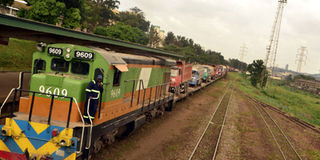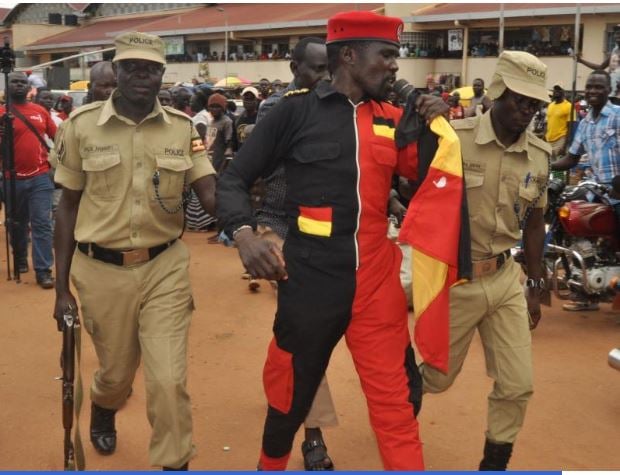Rail logistics study seeks to decongest Kampala

The rail wagon loaded with 24 trucks on arrival at Kampala railway station from Mombasa. A new rail logistics study is being conducted to create an efficient, cheaper and seamless inter rail linkage between key trade logistic hubs in the country. PHOTO BY MICHAEL KAKUMIRIZI
What you need to know:
New picture. According to NDP, country’s blue print, The Government will focus on addressing the infrastructure challenge of through investing in railway and road infrastructure among others.
The Uganda rail track is metre gauge. The government is in the process of constructing a standard gauge railway between Tororo –Pakwach and Kampala- Tororo and Malaba -Kampala
Kenya-Uganda Railway line built by the British. It stretches from the Port of Mombasa to Kampala in Uganda, touching major economic towns within the region.
Up to $650,000 (Shs2.4 billion) has been committed to supporting the country’s logistics sector, including conducting a rail logistics study with a view to improve rail infrastructure.
The study, which has already commenced, seeks to review the current strategy by government to develop an efficient low-cost freight logistics rail corridor.
If all goes according to plan, the ultimate result should be an efficient, cheaper and seamless inter rail linkage between key trade logistic hubs and other related trade infrastructures across the country.
Impact
This, according to trade and transport specialists is expected to spur export and imports trade while boosting regional trade including between Uganda and the Democratic Republic of Congo (DRC).
Consultation with stakeholders such as the Ministry of Works and Transport and related key agencies under the line ministry have all been undertaken. Key sector players, among them the National Logistic Platform (NLP) and Uganda Chambers of Mines and Petroleum among other actors have all been involved.
Prosper Magazine, however, understands that the scope of the study has been amended to include Kampala-Kasese, Bukasa Port-Mwanza and Bukasa Port-Kisumu.
For the case of Kampala-Kasese, the impact of the reserved cooper mining and oil reserves on Uganda logistics and transport will be key.
For Bukasa Port-Mwanza and Bukasa Port-Kisumu, the emphasis is to develop the two neighbouring countries—Tanzania and Kenya.
The study will explore the possibilities of decongesting Kampala by studying the city’s goods shed. This will be in addition studying developments in the emerging oil industry and its impact on the rail corridors under study.
The study will also review logistics sector development in Kenya and its impact here (on Uganda’s logistics sector) and report on Mukono inland railway container depot (ICD) project with the view of making recommendations for future projects.
Inking the deal
After assessing delivery capacity of Private Sector Foundation (PSFU), TradeMark East Africa (TMEA) for the second time, committed $650,000 (about Shs2.3 billion) to the private sector apex body in the country to enforce the project.
According to TMEA, the support (funding) is expected to enhance capacity of heavy vehicle commercial drivers, develop a strategy for rail logistics.
Speaking after the signing ceremony in Kampala about a fortnight ago, TMEA senior director, business competitiveness, Ms Waturi Matu, said: “Our interests is to support trade and partner with likeminded. There is goodwill by PSFU and we have also seen the same at the government level. This partnership will result in not only improving trade environment but also the discipline of heavy commercial truck drivers.”
TMEA country director for Uganda and South Sudan, Mr Moses Sabiiti, the support the private sector apex body in the country will harness what he describes as Uganda’s “comparative advantage.”
He said Uganda’s goods in transit and those bound for re-export will be the major beneficiaries of the project once completed. The study will provide a synopsis of the relevance of this project.
Mr Sabiiti further noted that the study will be a key source of information for oil and gas players on compliance and standards expected of actors in the multi-million dollar industry.
In the oil sub-sector, 111 exploration and appraisal wells have been drilled in the country since 2006, out of which 99 wells encountered oil and/or gas in the subsurface. This represents a success rate of over 89 per cent, one of the highest globally.
The total oil reserves confirmed in place is estimated at 6.5 billion barrels of oil and 100 billion cubic feet of gas in less than 20 per cent of the Albertine Graben, with 1.5 billion barrels recovery.
Dr Merian Sebunya, the chairperson of NLP, whose fraternity are the main beneficiary, some of whom cannot wait to cash in on oil and gas opportunities, said the deal funded through TMEA by the development agencies of countries such as Belgium, Canada, Denmark, European Union, Finland, Ireland, Netherlands, Norway, United Kingdom and United States of America, is a catalyst that will result in reduced costs of doing business.




